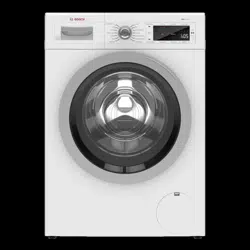Documents: Go to download!
- Owner's manual - (English)
- INSTALLATION INSTRUCTIONS
- OPERATING INSTRUCTIONS
- Cleaning and maintenance
- Troubleshooting
Table of contents
User Manual Washer
INSTALLATION INSTRUCTIONS
Tools needed
The following tools may be helpful during installation of your washer.

- 13mm socket for removing the transport bolts.
- 17mm wrench for adjusting the appliance feet.
- Bubble level for leveling the appliance.
Parts provided with your washer
Back side of the washing machine
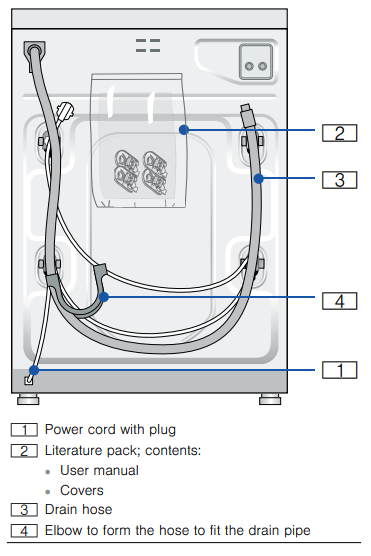
Washer drum contents
Two AquaShield water supply hoses are shipped in the washer drum. Be sure to remove each of these and use these new hoses for the installation.
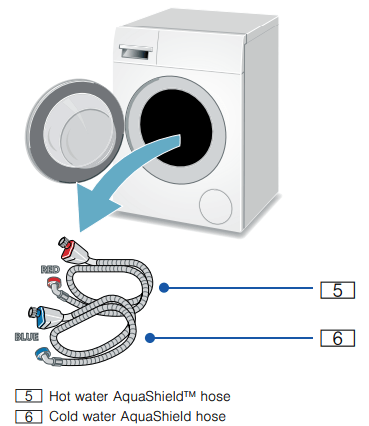
Remove the transport bolts
1. Remove drain hose from all brackets.
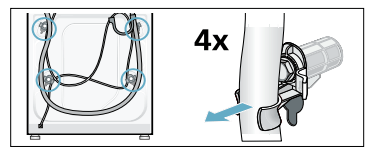
2. Loosen and remove all 4 transport bolts.
Remove the sleeves. Take the power cable out of the brackets.

3. Place covers over the transport bolt holes.
Four plastic covers are provided in the small parts bag included with your washer. Separate these covers and install one in each hole where the transport bolts were removed. Lock covers firmly by pressing on the snap hook

NOTICE: Keep the assemblies together and store them for later use such as when moving the washer.
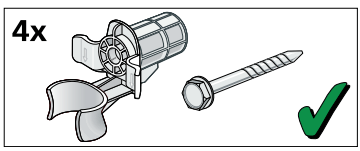
Water connections
Water supply hose connections
NOTICES
- The washing machine must only be operated with cold and hot (max. 140 °F/60 °C) tap water. Do not connect the appliance to the mixer tap of a pressurized hot-water boiler.
- To prevent water damage, the hot and cold water valves should be accessible when the washing machine is in place and should always be turned off when the washing machine is not in use.
- If installing the washing machine in a new building or a building in which the plumbing system was recently installed or upgraded, flush the lines before installing the washing machine to remove any sand, dirt or residue.
- To prevent leakage or water damage, follow the instructions in this chapter.
- If in doubt, have the appliance installed by an authorized service provider. Connect your washer to the wall faucets using the included AquaShield™ water supply hose. Observe each of the following:
- Only use the new water supply hose shipped with your washer. Never use old used hoses.
- The water supply hoses must not be kinked, bent, or pinched causing hose damage or restricting water flow.
- The water supply pressure must be between 14.5 to 145 psi (1 - 10 bar) with a minimum of 2.2 U.S. gallons (8 liters) of flow per minute. A pressure regulator valve must be installed if the maximum water pressure is exceeded.
- Make sure the water supply faucet is easily accessible when the washer is in use. The faucet should be turned off if the washer is going to be unused for extended periods of time.
- Make sure rubber washers are in place at both ends of the water supply hose. Missing washers could cause leaks.
- The connection points are under full water pressure. Turn on the water tap and check for leaks.
- Periodically inspect the water supply hose and replace with a new hose if cuts, kinks or leaks are observed

Water connection hoses
- red - Hot water-hose
- blue - Cold water-hose

Attach this end to water tap. Hand tighten only.
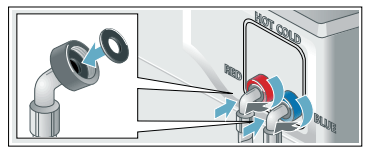
Position hoses as shown when routing hoses to right side of washer (facing from front).

Position hoses as shown when routing hoses to left side of washer (facing from front).
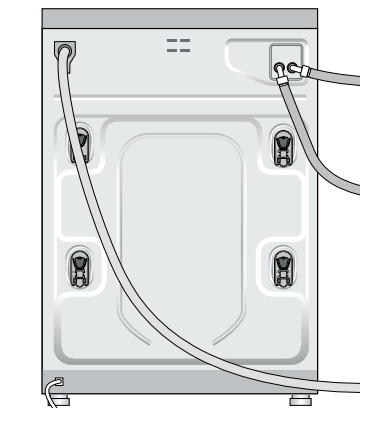
About the AquaShield™ Hose

The AquaShield hose prevents potential flooding in the event the hose develops an internal leak. If the hose leaks, the indicator turns red and water flow is blocked. Once the internal valve in the hose activates (indicator is red) the hose must be discarded. Contact Customer Service to purchase a replacement.
Types of drainage hookups
Standpip

Attach the drain hose to the elbow included with your washer. Position the elbow on the drain hose 4" from end of hose as shown. Insert this section of the drain hose into the drain pipe. Secure the elbow and hose with a nylon tie strap or the equivalent to keep the hose from coming out of the drain pipe during use.
Sink sipho

Secure the drain hose to the sink siphon using a Ø 0.9 - 1.6 in. (20-44 mm) hose clip (available from a hardware store).
Wash Basin
Make sure that:
- There is no stopper in the sink drain.
- The end of the hose does not touch the discharge water.
- The sink drain is free flowing and not partially clogged.
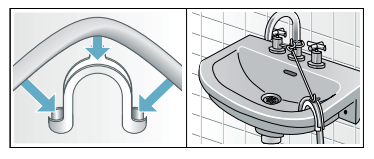
Attach the drain hose securely to the wash basin.
Transporting the washer
Before transporting the washer
1. Disconnect the washer power cord from the wall outlet.
2. Turn off the water supply to the washer.
3. Disconnect water supply lines from the tap.
4. Disconnect the drain hose from the drain location.
5. Install the transport bolt assemblies as shown in the following images.
Remove the transport bolt hole covers
1. Remove all four transport bolt hole covers.
2. Pull the tip of the arrow on the cover out slightly to disengage the locking tab.
3. Rotate the cover counterclockwise to remove. Repeat for all 4 transport bolt hole covers.
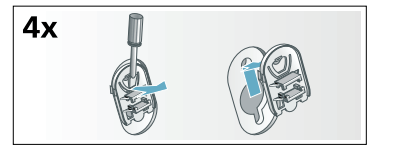
Control panel
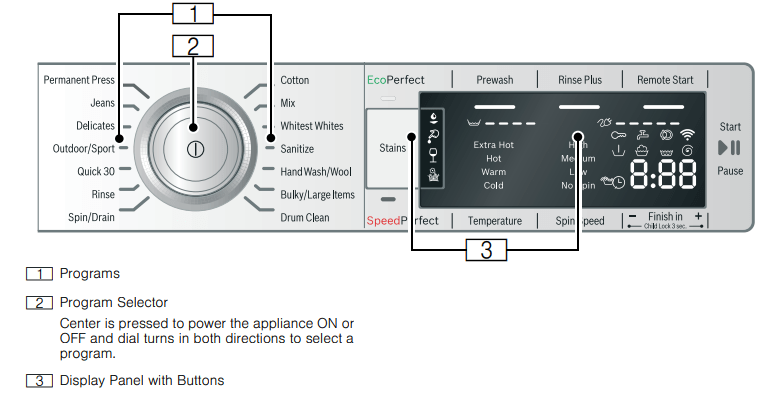
Display area
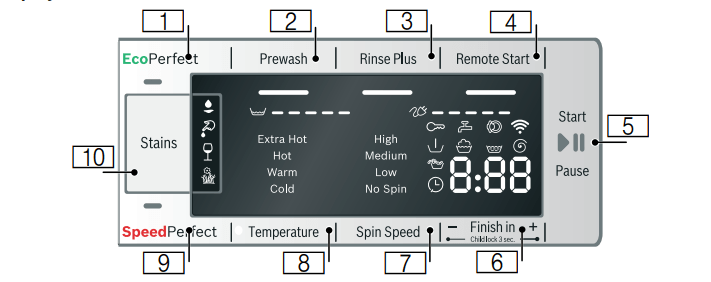
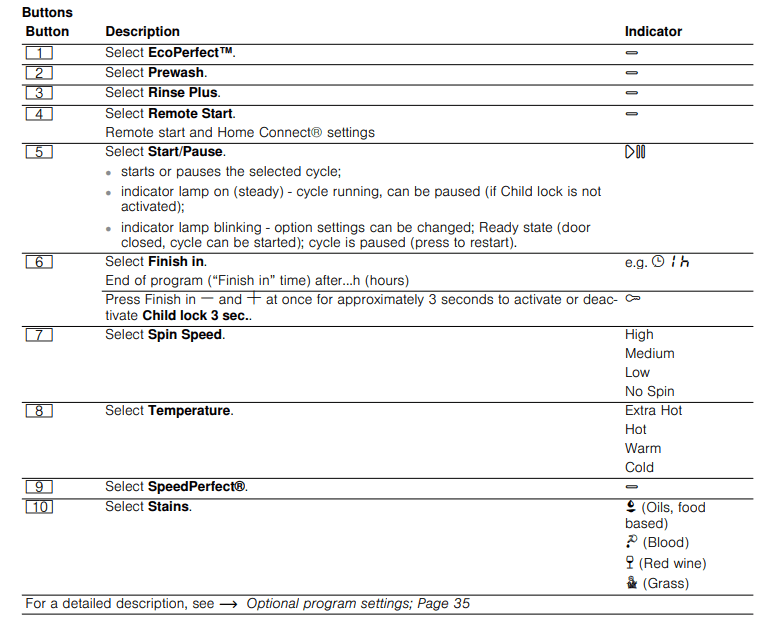
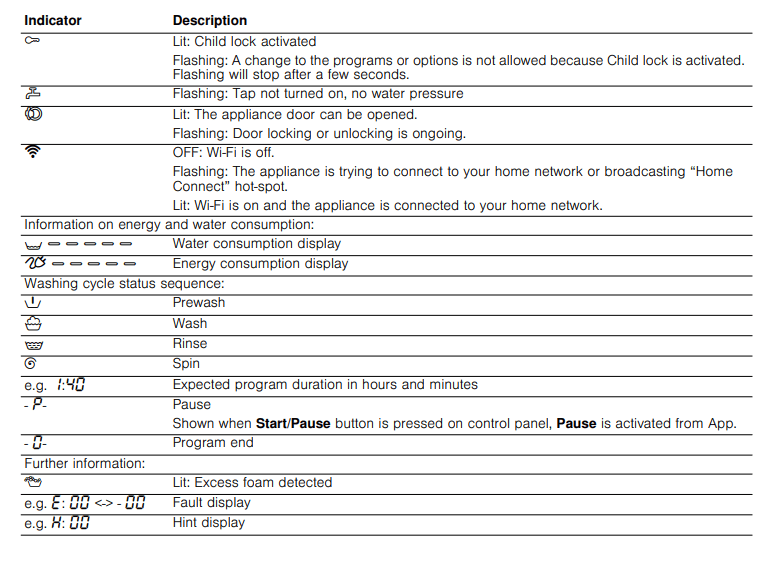
OPERATING INSTRUCTIONS
Loading the laundry
Loosen the laundry being loaded and mix small and large items
Unfold the sorted items and place them loosely in the drum. Mix small and large items to help them better distribute in the drum during the spin cycle.
Tip: Do not exceed the maximum load recommended for the type of wash. Overloading will cause poor wash results and will cause wrinkles.
Recommended Load Size
Recommended maximum load size can be found:
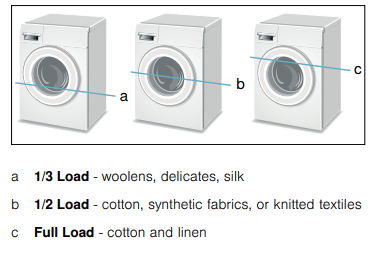
Tips
After loading, close the door carefully so as not to trap any items between the door and the rubber seal. The door should close easily and should not be forced to close.
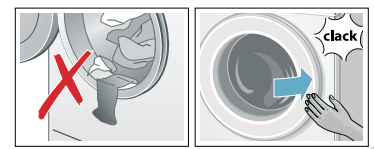
Foreign objects left in the drum may damage laundry. Before inserting any laundry, check to make sure no foreign objects are in the drum.
Filling the detergent and additives compartments
NOTICE: Damage to the appliance Detergent and laundry pre-treatment aids (e.g. spot remover, pre-wash sprays, etc.) can cause damage if they come into contact with the surfaces of the washer. Do not let these substances touch the surfaces of the washer. If necessary, wipe off traces of spills or drops immediately with a soft cloth.
Measuring
Measure out the detergent and laundry care products according to:
- the water hardness; consult your water utility company for details
- the manufacturer's instructions on the packaging
- quantity of laundry
- amount of soiling (heavy, normal, light)
Filling
Pour the detergent and laundry care product into the appropriate chambers:

1. Open the detergent dispenser tray.
2. Add detergent or additive. Avoid overfilling the compartment to prevent early dispensing.
3. Close the detergent dispenser tray completely before starting the wash cycle.
Tip: DO NOT operate the washer without the detergent compartment in place and fully closed. Detergent pods may be used but do not place them in the detergent compartment they must be placed in the bottom of the tub before adding the wash load.
Liquid detergent insert
To measure liquid detergent:
1. Pull out the detergent dispenser tray.
2. Push the liquid detergent insert forward and down as shown.
3. Pour liquid detergent into the chamber and do not exceed the maximum mark.
4. Reinsert the tray into its compartment.
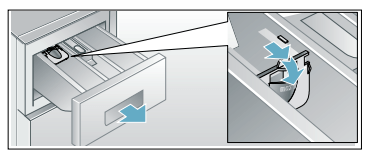
Starting the program
Press the Start/Pause button. Indicator lamp lights up and the program starts.
Foam detection
If you use too much detergent, too much foam may be formed during the wash cycle. The symbol Å lights up. Foam may be also leaking out from the detergent drawer. In order to remove the foam, the appliance automatically activates additional rinse cycles. This extends the program duration.
Selecting a different program
If you have inadvertently started the wrong program, you can change this as follows:
1. Press Start/Pause.
2. Select another program.
3. Press Start/Pause. The new cycle starts from the beginning.
Pausing/Adding a garment to the cycle
For adding a garment after the cycle begins.
1. Press Start/Pause. Door will unlock when safe to do so.
2. Open door carefully and add or remove laundry item. NOTICE: You can do this as long as the Start/Pause indicator flashes and it is safe to do so.
3. Close door.
4. Press Start/Pause. The cycle continues
Cancel program
For cycles with a high temperature:
1. Press Start/Pause.
2. Cool the laundry off: Select Rinse.
3. Press Start/Pause.
For cycles with a low temperature:
1. Press Start/Pause.
2. Select Spin/Drain and Spin Speed option to No Spin.
3. Press Start/Pause.
Program end
 appears in the display field and the Start/Pause button indicator lamp is off.
appears in the display field and the Start/Pause button indicator lamp is off.
NOTICE: If this symbol  appears in the display, the washer has detected too much foam and it automatically adds an additional rinse cycles to remove the foam. Use less detergent the next time you run the washer with the similar load.
appears in the display, the washer has detected too much foam and it automatically adds an additional rinse cycles to remove the foam. Use less detergent the next time you run the washer with the similar load.
Removing laundry/switching the appliance off
1. Open the front door of the washer and remove the laundry.
2. Press the center of Program Selector to switch off the appliance.
3. Turn off the water taps.
NOTICES
- Do not leave any laundry in the drum. It can shrink or become discolored by the next laundry load.
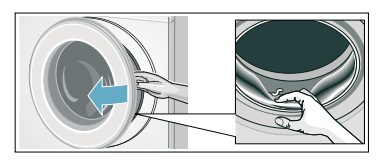
- Remove any remaining items from the drum and rubber gasket.
- Leave the front door and detergent drawer open so that any remaining water can dry.
- Always wait for the end of the cycle before switching off the appliance; otherwise the appliance may still be locked. If locked, switch the appliance on and wait until it unlocks.
- If the display panel switches off and the Start/Pause button indicator is blinking at the end of a program, the Energy-saving mode is active. To activate the display, press any button.
Home Connect®
Before you can use the Home Connect functions, you will need to carry out the following steps:
1. Install the Home Connect app on your mobile device.
2. Register in the Home Connect app.
3. Connect your appliance to your home network automatically or manually (you only need to do this the first time). 4. Connect your appliance to the Home Connect app.
Calling up the Home Connect menu
In the Home Connect menu, you can create and view network connections, reset network settings, activate/ deactivate Wi-Fi and find other Home Connect functions.
1. Switch the appliance on.
2. Press and hold Remote Start for at least 3 seconds.  appears in the display. You are now in the Home Connect menu.
appears in the display. You are now in the Home Connect menu.
Note: Briefly press Remote Start to exit the Home Connect menu.
Connecting your home network to the Home Connect app
Connect your appliance to the home network automatically or manually (you only need to do this the first time).
Connecting to your home network automatically
1. Press Start/Pause.
The appliance now attempts to connect to your home network.  flashes in the display.
flashes in the display.
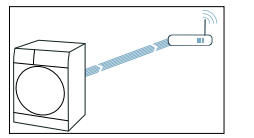
2. Activate the WPS function on your home network router within the next 2 minutes.
If the appliance has connected to your home network successfully,  appear in the display and light up continuously.
appear in the display and light up continuously.
Note: If you are not able to establish a connection, check whether your appliance is within range of your home network. Try connecting automatically again or connect your appliance manually.
Connecting to your home network manually
1. Set the program to position 2.
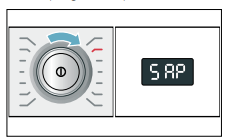
 (connect manually) appears in the display.
(connect manually) appears in the display.
2. Press Start/Pause. The appliance now sets up its own Wi-Fi network with the name (SSID) Home Connect.

3. Call up the Wi-Fi setting on the mobile device.
4. Connect the mobile device to the HomeConnect Wi-Fi network and enter the password (key) HomeConnect. Your mobile device now connects to the appliance. The connection process may take up to 60 seconds.
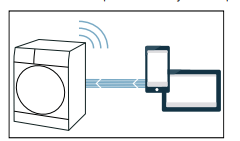
5. Once you have connected successfully, open the Home Connect app on your mobile device and carry out the steps in the app.
6. In the Home Connect app, enter the network name (SSID) and password (key) for your home network.
7. Carry out the last steps in the Home Connect app to connect your appliance. If the appliance has connected to your home network successfully,  appear in the display and light up continuously.
appear in the display and light up continuously.
Connecting to the Home Connect app
1. Set the program to position 3.
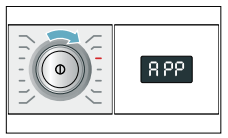
 (connect to app) appears in the display.
(connect to app) appears in the display.
2. Press Start/Pause. The appliance now attempts to connect to the Home Connect app.
3. Once your appliance is displayed in the app, carry out the last steps in the Home Connect app.
Note: If you were not able to establish a connection, check whether your mobile device is within range of your home network or is connected to this. Try connecting to the Home Connect app again.
Activating/deactivating Wi-Fi
1. Set the program to position 4
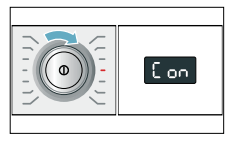
 (Wi-Fi function) appears in the display. 2. Press Start/Pause. If ©Ÿ appears in the display, Wi-Fi is activated on the appliance. If
(Wi-Fi function) appears in the display. 2. Press Start/Pause. If ©Ÿ appears in the display, Wi-Fi is activated on the appliance. If  appears in the display, Wi-Fi is deactivated on the appliance.
appears in the display, Wi-Fi is deactivated on the appliance.
Resetting your network settings
1. Set the program to position 5.
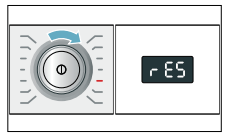
 (reset network settings) appears in the display.
(reset network settings) appears in the display.
2. Press Start/Pause.  appears in the display.
appears in the display.
3. Press Start/Pause.
Note: If you want to operate your appliance via the Home Connect app again, you will need to reconnect it to your home network and to the Home Connect app.
Laundry
Preparing the laundry
NOTICE: Damage to the appliance/fabrics Foreign objects (e.g. coins, paper-clips, needles, nails) may damage the laundry or components in the washing machine. Therefore, note the following tips when preparing your laundry:
- Empty all pockets to ensure no loose debris (coins, keys, other hard objects) are placed in the washer drum.
- Close any fasteners (such as zippers and hooks) that could cause laundry to catch or become entangled.
- Remove any foreign objects or non-washable parts.
- Turn trousers and knitted wear inside out prior to washing.
- Place small items (such as socks and handkerchiefs) and underwired bras into a mesh bag prior to washing.
- When washing laundry to be tumble-dried, use the correct amount of detergent and textile care products as specified in the manufacturer's instructions. Some detergents and textile care products, starch or softeners may contain chemicals that may become deposited on the moisture sensors negatively affecting their function and the drying result.
Sorting the laundry
Sort laundry items according to color, degree of soiling and recommended wash temperature range.
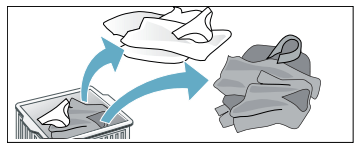
Wash white items separately from colored items. Otherwise, white items may tend to become grey.
Observe laundry care labels

Check the care labels on each laundry item prior to washing. They provide valuable information as well as limitations about the laundry process (temperature etc.) to help you choose an appropriate cycle.
Determining degree of soiling ▯
- Light soiling No visible soiling or stains, but may have absorbed some odor. This could include light weight summer clothing such as T-shirts, shirts, or blouses worn only once. Also to freshen bed linen or guest towels.
- Normal soiling Visible soiling and/or a few light stains. This could include clothing such as T-shirts, shirts, or blouses that have been sweated in or worn several times. Also tea towels, hand towels or bed linen used for up to one week or more. Curtains without stains that have not been washed for up to a half year.
- Heavy soiling Visible soiling and stains. This could include kitchen towels, fabric napkins, baby bibs, children’s outer clothing or sports jerseys and shorts stained with grass or dirt. It could also include working clothes such as overalls and jeans and other clothing worn for outside work and activities.
Laundry detergents and additives
Laundry detergents and aditivesAdding the correct amount of HE detergent
Too much detergent
- Excessive foam will reduce washing agitation and cause poor washing and rinsing results.
- Not environmentally compatible (wastes detergent and is not good for the environment).
Too little detergent
- Laundry will not be washed clean.
- Eventually the laundry will take on a grey and hard appearance. Greyish-brown grease spots may stain the laundry, heating elements may begin to calcify.
The fabric care label is important for selecting the correct detergent, temperature and treatment of the laundry. If desired you can visit the following sites for additional information on detergents and fabric care.
- Standard detergent with optical brighteners Suitable for white laundry made from linen or cotton Program: Cotton / Cold - Extra Hot
- Detergent for colors without bleach or optical brighteners Suitable for colored laundry made from linen or cotton Program: Cotton / Cold - Hot
- Detergent for colors/delicates without optical brighteners Suitable for colored laundry made from easy-care and synthetic fabrics. Program: Permanent Press / Cold - Hot
- Detergent for delicates Suitable for delicate, fine fabrics, silk or viscose Program: Delicates / Cold - Hot
- Detergent for woolens Suitable for wool Hand Wash/Wool program: Cold - Warm
Program selection table
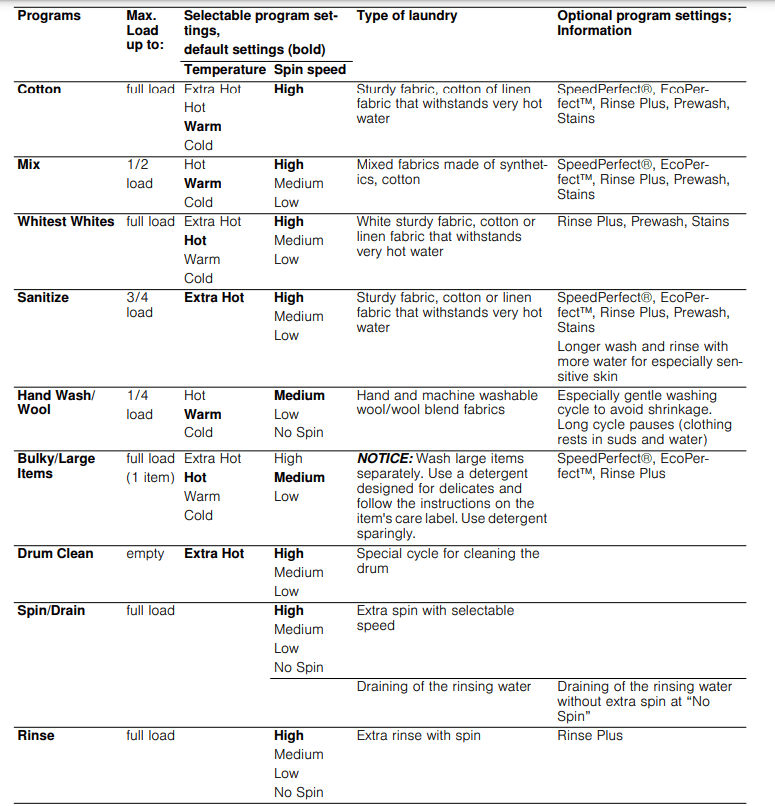
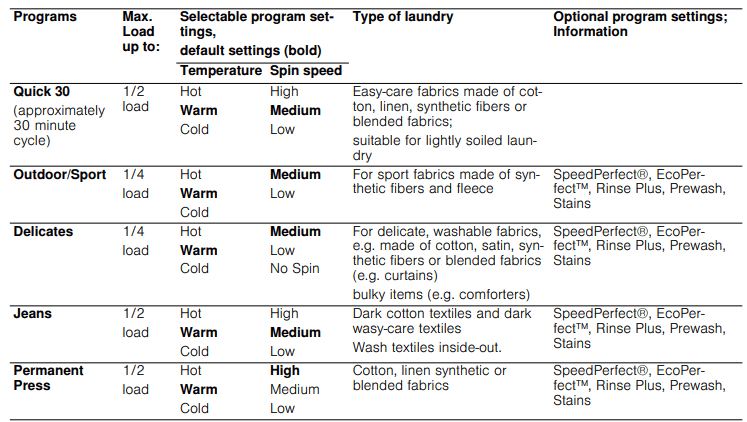
Optional program settings
EcoPerfect™
Energy optimised washing by reducing the temperature while achieving a washing result that is consistent with the selected program, without the EcoPerfect™ setting.
Prewash
For heavily soiled washing. Pour 1/3 of normal detergent amount into pre-wash chamber I and remaining 2/3 into main wash chamber II.
Rinse
Plus This feature adds additional rinses to selected program which is helpful for locations with soft water supplies or to generally improve rinsing results. It will increase the program duration.
Remote Start
Briefly pressing the Remote Start button activates or deactivates the Remote start function. Activating the Remote start function enables the appliance to be started remotely via the Home Connect® app.
Finish in
The program end (Finished in) time can be set in one hour increments to a maximum of 24 h (hours). After selecting the desired washing program (at the dial) but before pressing the Start/Pause button, press the Finish in button until the desired time is displayed, e.g. 8 h. Press the Start/Pause button to start the washer.
Spin Speed
Before and during the cycle, you can change the spin speed range depending on the cycle progress. Touch the appropriate button until the desired setting is displayed.
Temperature
Before and during the cycle, you can change the default temperature range depending on the cycle progress. Press the appropriate button until the desired setting is displayed.
SpeedPerfect®
For washing in a shorter time with a washing result comparable to that of the standard program.
Appliance settings
Child lock 3 sec.
To Activate/Deactivate, press Finish in - and + for approximately 3 seconds. In the display field, you will see the  symbol light indicating the Child lock is active.
symbol light indicating the Child lock is active.
NOTICE: The Child lock will remain activated after the end of the cycle and the door will remain locked. Even switching the appliance off and on will keep the door locked and will not deactivate the Child lock. You must deactivate Child lock and, if necessary, activate it again
Activating setting mode
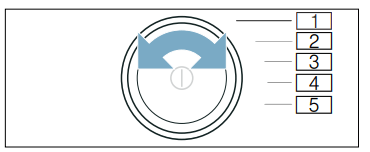
To enter or activate the setting mode:
1. Switch on the appliance. The indicator lamp of the program on position 1 (() lights up.
2. Press and hold Temperature button and, at the same time, turn the program selector to position 2 (0).
3. Release Temperature button. The setting mode is now activated.
Cleaning and maintenance
Cleaning the washer´s exterior
Clean the washer´s exterior surfaces when required as follows:
- Use hot soapy water or a mild (non-abrasive) cleaning agent.
- Dry with a soft towel.
- Remove residue immediately.
- Do not use high pressure spray
Cleaning the drum
Metallic debris left in the drum can produce rust spots on the drum. Never use steel wool to try to remove these. Use a chlorine-free cleaning agent and follow the manufacturer’s instructions.
Descaling the washer
Provided that you use correct amounts of detergent with your wash loads, descaling is not necessary. If descaling the washer drum does become necessary, please follow the descaling product manufacturer’s instructions. Small amounts of descaling agent can be used to remove white spots on the washer drum caused by lime or mineral deposits or small amounts of rust caused by metal objects left in the drum.
Cleaning the detergent dispenser tray
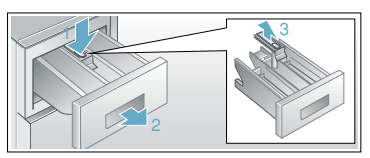
1. Open the detergent dispenser tray fully. Press down on the drawer catch (1) and pull the tray (2) from the washer.
2. Remove the insert (3) by grasping it and pulling it upwards from the detergent dispenser tray.
3. Clean the insert and the detergent dispenser tray by holding it under warm running water. Lightly wipe away any remaining detergent residue.
4. Attach the insert and slide the detergent dispenser tray back into place and close the tray securely.
Tip: Do not operate the washer without the detergent dispenser tray in place and completely closed.
Cleaning the water inlet strainers
Clean the strainers at the water tap end of the hose
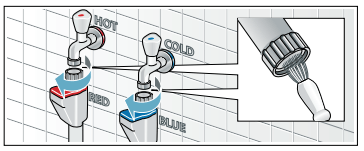
1. Remove the hose from the tap.
2. Rinse the strainer under running water. Look at the strainer to see if any visible debris is still present. Rinse again if necessary to remove the debris.
3. Reconnect the hose to the tap.
Clean the strainers at the washer end of the hose

1. Remove the hose from the inlet on the back of the washer.
2. Using narrow pliers, grasp and pull the strainer from the inlet port.
3. Rinse the strainer under running water.
4. Reconnect the hose to the back of the washer and turn on the water tap. Check to see if water flows by starting a warm water wash cycle
Cleaning the drain pump
1. If the washer has not been drained, try to drain it now. Turn the program selector to the Spin/Drain, select Spin Speed to No Spin and press the Start/Pause button. Wait a few moments to let the cycle drain the water from the drum. If the pump is totally blocked, the water will be unable to drain and the cycle will end.
2. Shut off the tap so that no more water flows in and has to be drained. Switch the appliance off. Unplug the power plug.
3. Open and remove the service cover.
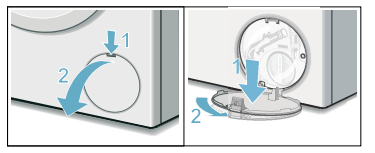
4. Loosen the screws and remove the protective film.
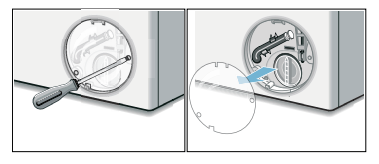
5. Use the pull-out drain hose located in the pump access opening to drain the remaining water into a suitable container (up to 5.3 U.S. gallons/20 liters of water may be drained). Pull the sealing cap from the hose and lay the hose over the side of the container and allow the water to finish draining from the drum. When finished, replace the sealing cap into the end of the hose and restore the hose to its storage location.
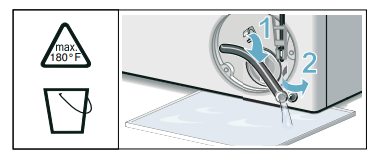
6. Turn the pump cover counterclockwise to remove it. A small amount of residual water may flow out when the cover is removed. Clean the interior of the pump housing, removing any debris or foreign objects. Check to be sure the impeller wheel at the back of the pump housing can now turn freely. Remove any lint, debris or detergent residue from the threads of the pump cover and the pump cover housing. Replace the pump cover by screwing tightly into position. Handle must be vertical.
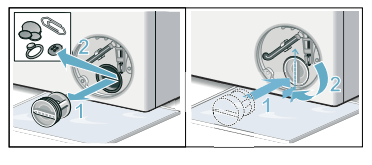
7. Reinstall the protective film over the pump access using both screws.
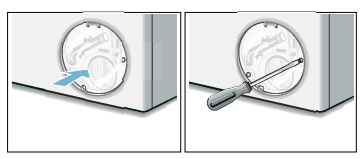
8. Snap the service cover in place at the hinges and close it. Wipe up any spilled water.

Troubleshooting
Emergency door lock release
In the event of a power interruption the program will continue running when the power supply has been restored. If the washer door must be opened and the normal door unlock procedures do not work, the emergency door lock release rod can be actuated to open the door.
1. Press the center of Program Selector to switch off the appliance. Any running program will then be cancelled. Disconnect the power plug.
2. Allow the water in the drum to cool off.
3. Allow the washer drum to come to a stand still (no longer spinning).
4. Before opening the washer door, perform the drain procedure included in the pump maintenance section.
5. Loosen screws and remove the protective foil.
6. The washing machine door can then be opened. Pull the emergency release downwards with a tool and release

7. The door can now be opened.
General Troubleshooting
1. Press the center of Program Selector to switch off the appliance.
2. Disconnect the appliance from the power outlet.
3. Turn off the water taps.
4. Call Customer Service.
Determing the Problem
| Problem | Possible cause(s) | Solution(s) |
| Washer door cannot be opened. | Child lock is activated. | Deactivate Child lock (press Finish in M and N for approximately 3 seconds). |
| A power failure occurred. | If a cycle is interrupted by a power failure, it will resume when the power is restored. If power is not restored follow the cautions and instructions for Emergency door lock release: ~ Emergency door lock release | |
| Cycle is running, or water level is too high and/or too hot or the drum is still spinning. | Wait until the cycle ends. | |
| Electric power cord has become loose or unplugged. | Make sure the electric cord is securely plugged in. | |
| Appliance switched off before end of cycle. | Switch the appliance on. | |
| Door still cannot be opened, even after turning the washer off and back on again. | Child lock is activated. | Deactivate Child lock (press Finish in - and + for approximately 3 seconds). |
| Door is locked for safety reasons (high water level, water temperature too high, drum is spinning). | Run a Spin/Drain program to reduce the water temperature and level. | |
| Wash cycle time is increased. | Your washer utilizes sensors to monitor certain characteristics of the wash load. Increases in wash cycle time could be due to: Solutions are based on the specific reason the wash time has been extended. The automatic unbalanced load detection system spins the laundry several times to ensure even distribution. |
Solutions are based on the specific reason the wash time has been extended. Always load the washer with a mixture of large and small wash items (easier to distribute in the drum). |
Excess suds.  displays at end of cycle. displays at end of cycle. |
Use less detergent. | |
| Washer does not start. Start/Pause indicator light does not flash. | Power cord end not inserted or not inserted correctly. Insert power cord end correctly. A fuse is blown or breaker is tripped. |
Insert power cord end correctly. Replace fuse or reset breaker. For replacing the fuses in the supplied Power Adapter refer to the instructions which came with the Power Adapter |
| Door not closed properly | Check if laundry is caught in the door. Close the door until you hear it click shut completely. | |
| The display panel and indicator lights switch off, Start/Pause indicator flashes. | Energy-saving mode is activated. | Press any button to activate the display. |
| The display panel and Start/Pause indicator switch off | Automatic switch-off function is active. | Press the center of the Program Selector to switch on the appliance. |
| Cycle does not start - Start/Pause flashes. | Start/Pause button not pressed. | Press the Start/Pause button to start the cycle. |
| Cycle does not start - Finish in-time is displayed. | A delayed starting time has been selected and activated. | Wash cycle will begin at proper time to complete at the selected Finish in-time. |
Cycle does not start  symbol flashes. symbol flashes. |
Child lock is activated. | Deactivate Child lock (press Finish in - and + for approximately 3 seconds). |
| Detergent residue remains in the detergent dispenser. | Dry detergent may have been damp or lumpy. | See Adding the correct amount of HE detergent to determine proper detergent usage. ~ Adding the correct amount of HE detergent; Page 32 |
| Excess liquid detergent may have been added. | ||
| Water does not appear to be filling into the washer or detergent is not dispensed from detergent tray. | Start/Pause not pressed. | Press Start/Pause. |
| Water taps not turned on. | Turn on water taps. | |
| Supply hose kinked or pinched (reduce flow). | Eliminate the cause | |
| Water supply hose strainers clogged. | Clean the water inlet strainers. | |
| Water pressure too low. | Eliminate the cause. | |
| Water cannot be seen in the drum. | The water level in your high efficiency front load washer is below the visible part of the drum, this is normal | No action needed. |
| Water has not drained completely | Suds may be excessive (usually due to too much detergent or nonHE detergent being used). | Use less detergent for future loads. Be sure to use only high efficiency HE-detergents. |
| Pump is blocked. | Check and clean the drain pump, water drain hose and/or the drain pipe. | |
| Drain hose or drain pipe is blocked | Clean drainage pipe and/or drainage hose. | |
| Water is coming out from underneath the washer. | Water supply hose is leaking: is not screwed on tight at both ends, or rubber washer not placed in hose. | Eliminate the cause: tighten the hose (by hand at the washer end), check for rubber washer in place. |
| Drain hose is leaking. | Check the drain hose, be sure that it is on the washer securely with the clamp in place; replace the drain hose if leaking continues. | |
| Foam comes out of the detergent dispenser drawer. | Too much detergent was used, or a non-HE detergent was used; pump was not able to pump out the increased suds | Immediate fix: mix 1 tablespoon of fabric softener with 1/2 liter (1 pint) of water and pour this mixture into the detergent compartment, except if there is waterproof type textiles in the load then do not use softener to reduce the foam. To prevent: use less detergent for future wash loads. |
| Repeated spinning | The Unbalanced Load Detection system is attempting to balance the load through repeated spin cycles. | To prevent: always load the washer with a mixture of large and small wash items (easier to distribute in the drum). |
| No spin took place (laundry is still wet). | Load size too small. Add more laundry. | Add more laundry |
| Large items may have become entangled in the drum and could not be distributed by the Unbalanced Load Detection system; spin cycle therefore canceled for safety reasons. | To prevent: always load the washer with a mixture of large and small wash items (easier to distribute in the drum). | |
| Excessive suds: too much detergent was used, or a non-HE detergent was used. | Immediate fix: mix 1 tablespoon of fabric softener with 1/2 liter (1 pint) of water and pour this mixture into the detergent compartment, except if there is waterproof type textiles in the load then do not use softener to reduce the foam. To prevent: use less detergent for future wash loads. | |
| Detergent residue on the laundry. | Some phosphate free detergents contain water insoluble ingredients that may appear as light spots on the laundry. | Brush off when laundry is dry or execute the program Rinse. |
| System shakes or shudders when spin speed increases. | The washer drum suspension system shifts during spinning as the speed increases. This may result in a slight shaking of the washer during the spin speed transition. | Mix small and large laundry items together in the load to minimize this effect. Check to be sure the washer is level and all four feet press equally against the floor. |
 does not appear in the display panel. does not appear in the display panel. |
Wi-Fi is switched off. | To connect to your home network, switch on Wi-Fi. |
| Wi-Fi is switched on but a connection to the home network cannot be established. | Check whether your home network is available or try to connect to your home network again. | |
| Home Connect™ is not working. |
|
Information on the display area
| Problem | Possible cause(s) | Solution(s) |
 flahes flahes |
Door not closed properly or attempting to lock or unlock. | Check that no laundry is caught between the door glass and gasket and close door securely. Wait until door is locked or unlocked. |
 flashes flashes |
Cold water tap not turned on | Turn on the cold water tap. |
| Supply hose for cold water kinked or pinched closed. | Eliminate the cause, replace the hose if damaged. | |
| Strainer in water supply hose clogged. | Clean the water inlet strainer. | |
| Cold water pressure too low | Eliminate the cause. | |
 lights up lights up |
Too much detergent used or nonHE detergent used. | Use less detergent for future loads. Only use HE detergents. |
| The Drum Clean program indicator flashes | Indicates Extra Hot wash temperature has not been used in recent wash cycles | Run a Drum Clean or other program with Extra Hot temperature option selected and without laundry |
 is shown is shown |
Hot water tap not turned on. | Confirm hot water hose is correctly connected and turn on the hot water tap. |
| Supply hose for hot water kinked or pinched closed. | Eliminate the cause, replace the hose if damaged. | |
| Hot water pressure too low | Eliminate the cause. | |
| Strainer in water supply hose clogged. | Clean strainers in supply hoses. | |
 |
Pump is blocked (obstructed). | Clean the washer drain hose and/or the drain pipe. May need to perform pump maintenance to clear blockage. |
 |
Water in the base, appliance leaking. | Turn off the water tap. Call the Customer Service. |
| others | Turn off machine, wait 5 seconds and turn on again. If the the problem persists, call Customer Service. |
See other models: WTG865H4UC HBA23B150E/03 HBL5751UCC TDI9025GB/02 SHE33T52UC
